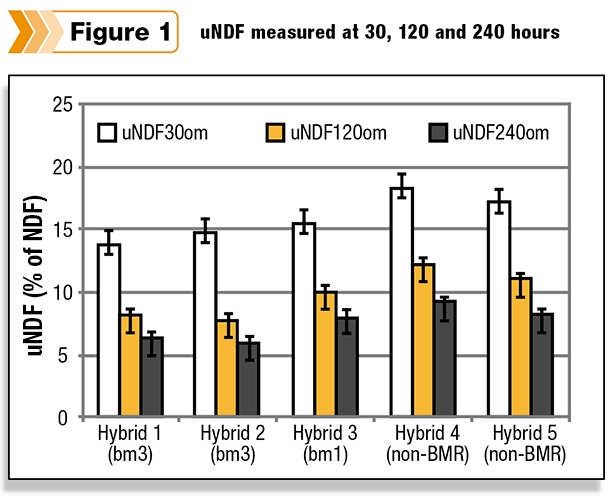Dual-purpose, leafy and BMR hybrids are three main types of corn grown for silage on dairies today. Dual-purpose hybrids were designed for grain or high-quality corn silage production. In general, dual-purpose hybrids have high grain production potential and moderate fiber digestibility.
In general, 30-hour neutral detergent fiber (NDF) digestibility for dual-purpose does not vary widely (i.e., by 2 to 5 percent) when grown at the same location and harvested at optimum moisture content.
Leafy corn hybrids were developed with the goal of feeding high-quality corn silage to dairy cows to increase profitability and are considered silage-specific. Francis Glenn of Glenn Seed Ltd., Blenheim, Ontario, developed the first leafy corn varieties in the 1980s, and today his parent lines are used by seed companies in the U.S., Canada and other countries.
Leafy hybrids have at least eight leaves above the ear and a lower ear placement on the stalk compared to dual-purpose. Some data also suggest leafy can have a small NDF digestibility advantage over dual-purpose. Current leafy breeding efforts are developing full floury kernel texture to increase rumen starch availability.
The BMR trait was discovered in 1924 at the University of Minnesota and is a naturally occurring mutation. Forty years later, it was discovered that the BMR trait confers lower lignin content and therefore significantly greater whole-plant fiber digestibility compared to dual purpose and leafy (non-BMR) varieties.
There are four known BMR genotypes that differ in fiber digestibility. Dow AgroSciences/Mycogen Seeds utilize the bm3 gene while Dupont/Pioneer use the bm1 gene in their BMR products.
BMR was released commercially in the 1990s and had mixed success on farms due to low yields and vulnerability to stress. In general, trials have shown that BMR is more digestible and has more milk yield potential per ton compared to non-BMR.
However, BMR’s fiber digestibility advantage comes at the expense of a lower dry matter yield compared to non-BMR. BMR is typically 8 to 12 percentage units greater in fiber digestibility. Since its initial release, BMR yield potential has improved and is generally in the range of 80 to 90 percent of non-BMR yield.
While feeding trials have consistently shown greater milk production potential of BMR when fed in rations, drawbacks to BMR include lower dry matter yield per acre and a higher seed cost. Relatively little research has evaluated yield and quality among both bm1 and bm3 compared to non-BMR.
Dairy farmers and others in the industry are interested in nutritional differences between bm1 and bm3 and how best to utilize hybrids in rations to optimize milk production and profitability.
With funding from the Northern New York Agricultural Development Program, Miner Institute conducted a field trial in 2015 to evaluate the agronomic performance of bm1, bm3 and non-BMR hybrids. Hybrids were arranged in a randomized complete block design with four replicated strips per hybrid (six rows, 500-foot lengths) and planted at 34,000 seeds per acre.
Relative maturity ranged from 95 to 107 days, and all plots were harvested on the same day.
Identical hybrids were grown at a cooperating dairy farm located approximately 25 miles south of Chazy, New York (Adirondack Farms, LLC) to serve as a comparison to the replicated trial results.
In addition to yield and moisture content, fresh chop and fermented samples were analyzed for a range of forage quality measures including fiber content (ADF and NDF), crude protein (CP), soluble protein (SP), 30-hour NDF digestibility expressed on an organic matter basis (NDFd30om), lignin, starch, seven-hour digestible starch (starch-D) and undigested NDF content as a percentage of dry matter (at 30, 120 and 240 hours).
Results showed that yield (at 35 percent dry matter content) ranged from 16.9 to 18.4 tons per acre and did not differ significantly among hybrids. Dry matter at harvest ranged from 35 to 38 percent, and starch content ranged from 34 to 36 percent with no differences among hybrids.
For fresh-chop samples, starch-D ranged from approximately 54 to 64 percent and was lowest for bm1 (hybrid 3) and significantly greater for non-BMR. Starch-D increased by greater than 10 percentage units at 30 days post-fermentation across hybrids (73 to 79 percent), with minor differences compared to fresh chop.
There was nearly a 10 percentage unit difference in fiber digestibility across hybrids, with bm3 having higher NDFd30om; however, there was no significant difference between bm1 and bm3. As expected, there was a difference for lignin (BMR range: 1.8 to 2 percent of dry matter; non-BMR: 2.5 to 2.6 percent of dry matter); however, there was no difference in lignin content between bm1 and bm3.
Differences in NDFd30om have important implications for ration formulation, dry matter intake and milk production potential. In rations with greater than 40 percent corn silage, a recent study showed that milk potential increased by 0.31 per pound per cow per day for each percentage unit increase in fiber digestibility.
Fiber digestibility and indigestibility affect feed intake, rate of forage particle breakdown, ruminal turnover and efficiency of milk production.
Some nutritionists suggest including uNDF in routine forage analyses, since it is a uniform feed fraction with a predictable digestibility and can be used to estimate fast and slow fiber digestion pools to fine-tune rations.
With regard to nutrition modeling (such as the Cornell Net Carbohydrate Protein System, CNCPS), indigestible NDF (iNDF) can be estimated by the amount of uNDF after 240 hours of in vitro digestion (termed undigested NDF or uNDF).
In our study, uNDF was measured at 30, 120 and 240 hours (abbreviated as uNDF30om, uNDF120om and uNDF240om). There were distinct differences in uNDF, with BMR having significantly lower uNDF30om (13.8 to 15.5 percent of dry matter), with no statistical difference between bm1 and bm3 (see Figure 1).

The bm3 hybrids had significantly lower uNDF120om compared to bm1 and non-BMR. There was no difference in uNDF120om between bm1 (9.9 percent of dry matter) and non-BMR (11.0 and 12.2 percent of dry matter).
The bm3 hybrids also had significantly lower uNDF240om (5.9 and 6.2 percent of dry matter) compared to bm1 (7.9 percent of dry matter) and non-BMR (8.2 and 9.2 percent of dry matter), implying greater fiber digestibility.
Trends for hybrids grown at Adirondack Farms were similar, with larger differences in fiber digestibility among hybrids. For example, hybrid one (bm3) had greater than 13 percentage units greater NDFd30om compared to non-BMR. In addition, bm3 had a greater than 5 percentage unit advantage over bm1.
The greater difference in fiber digestibility observed may have been related to being grown in multiple environments compared to the trial at Miner Institute, where all hybrids were planted in the same field.
Our results demonstrate important nutritional quality differences among the hybrids tested and stresses the need for wise hybrid selection and forage analysis when formulating rations. Fiber digestibility and indigestibility varied significantly among BMR and non-BMR hybrids and between bm1 and bm3.
Results indicate uNDF was a good indicator of fiber digestibility and suggest it could be used as part of a hybrid-ranking tool to evaluate milk production potential.
Future research will include evaluating milk potential using CNCPS and will explore impacts of harvest timing and year-to-year weather variability on fiber digestibility. Year two of this trial is currently underway – so stay tuned. ![]()
References omitted but are available upon request. Click here to email an editor.

-
Eric Young
- Agronomist
- William H. Miner Institute
- Email Eric Young










